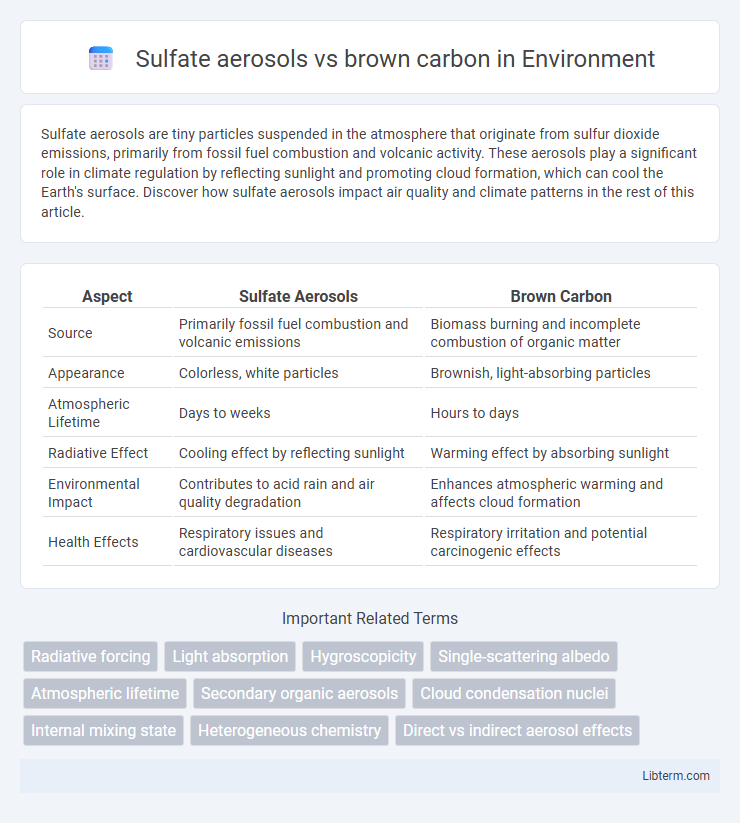Sulfate aerosols are tiny particles suspended in the atmosphere that originate from sulfur dioxide emissions, primarily from fossil fuel combustion and volcanic activity. These aerosols play a significant role in climate regulation by reflecting sunlight and promoting cloud formation, which can cool the Earth's surface. Discover how sulfate aerosols impact air quality and climate patterns in the rest of this article.
Table of Comparison
| Aspect | Sulfate Aerosols | Brown Carbon |
|---|---|---|
| Source | Primarily fossil fuel combustion and volcanic emissions | Biomass burning and incomplete combustion of organic matter |
| Appearance | Colorless, white particles | Brownish, light-absorbing particles |
| Atmospheric Lifetime | Days to weeks | Hours to days |
| Radiative Effect | Cooling effect by reflecting sunlight | Warming effect by absorbing sunlight |
| Environmental Impact | Contributes to acid rain and air quality degradation | Enhances atmospheric warming and affects cloud formation |
| Health Effects | Respiratory issues and cardiovascular diseases | Respiratory irritation and potential carcinogenic effects |
Introduction to Atmospheric Aerosols
Sulfate aerosols are tiny particles formed primarily from sulfur dioxide emissions that reflect sunlight, leading to cooling effects in the atmosphere. Brown carbon, a component of organic aerosols, absorbs solar radiation and contributes to atmospheric warming through light absorption, particularly in the ultraviolet and visible spectrum. Both sulfate aerosols and brown carbon play critical roles in climate regulation and air quality, influencing radiative forcing and cloud formation processes.
What are Sulfate Aerosols?
Sulfate aerosols are tiny particles composed mainly of sulfuric acid and sulfate salts formed in the atmosphere from sulfur dioxide emissions, primarily from fossil fuel combustion and volcanic activity. These aerosols reflect sunlight, contributing to cooling effects on the Earth's climate by increasing the albedo of clouds and the atmosphere. Unlike brown carbon, which absorbs solar radiation and warms the atmosphere, sulfate aerosols predominantly scatter light and are key agents in atmospheric cooling and acid rain formation.
Understanding Brown Carbon
Brown carbon is a complex organic aerosol primarily composed of light-absorbing compounds derived from biomass burning and fossil fuel combustion, influencing atmospheric radiation and climate by absorbing solar radiation in the ultraviolet and visible spectra. Unlike sulfate aerosols, which predominantly scatter sunlight and cool the atmosphere, brown carbon contributes to atmospheric warming due to its strong absorption properties. Understanding the chemical composition, sources, and optical characteristics of brown carbon is crucial for accurately modeling its climate impacts and differentiating it from other aerosols in air quality and climate studies.
Sources of Sulfate Aerosols
Sulfate aerosols primarily originate from the oxidation of sulfur dioxide (SO2) emitted by fossil fuel combustion, volcanic eruptions, and marine phytoplankton activity. Industrial processes such as coal and oil burning contribute significantly to atmospheric sulfate concentrations, leading to cloud condensation nuclei formation and climate cooling effects. In contrast, brown carbon mainly comes from biomass burning and organic matter combustion, differing in chemical composition and radiative properties from sulfate aerosols.
Origins of Brown Carbon
Brown carbon primarily originates from incomplete combustion of organic matter, including biomass burning, fossil fuel combustion, and biofuel use, releasing complex organic compounds into the atmosphere. These organic particles absorb light strongly in the ultraviolet and visible spectrum, contributing to atmospheric warming, unlike sulfate aerosols which mainly scatter sunlight and cool the atmosphere. Brown carbon's chemical composition and optical properties vary widely depending on the combustion source and atmospheric aging processes, distinguishing its impact on climate from that of sulfate aerosols.
Chemical Composition and Properties
Sulfate aerosols primarily consist of sulfuric acid and ammonium sulfate, exhibiting strong scattering properties that increase atmospheric albedo and contribute to cooling effects. Brown carbon, composed of complex organic compounds including humic-like substances and polycyclic aromatic hydrocarbons, absorbs both ultraviolet and visible light, causing atmospheric warming and influencing photochemical reactions. The distinct chemical compositions result in sulfate aerosols being highly hydrophilic and promoting cloud condensation, while brown carbon shows variable hygroscopicity and impacts absorption-enhanced atmospheric aging processes.
Impact on Climate: Cooling vs Warming
Sulfate aerosols primarily reflect sunlight, resulting in a net cooling effect on the Earth's climate by increasing the albedo of clouds and the atmosphere. Brown carbon absorbs solar radiation, contributing to warming by directly heating the atmosphere and reducing the reflectivity of snow and ice when deposited. The contrasting radiative properties of sulfate aerosols and brown carbon play critical roles in regional and global climate forcing, with sulfate mitigating warming and brown carbon exacerbating it.
Effects on Air Quality and Health
Sulfate aerosols primarily originate from fossil fuel combustion and volcanic activity, contributing to atmospheric cooling but also causing respiratory issues by penetrating deep into the lungs. Brown carbon, emitted from biomass burning and incomplete combustion, absorbs sunlight and exacerbates atmospheric warming while irritating respiratory pathways and increasing the risk of cardiovascular diseases. Both pollutants degrade air quality by increasing particulate matter concentrations, amplifying health risks such as asthma, bronchitis, and other pulmonary disorders.
Measurement and Detection Techniques
Sulfate aerosols are commonly measured using techniques such as ion chromatography and aerosol mass spectrometry, which identify their chemical composition and concentration with high precision. Brown carbon detection relies heavily on spectroscopic methods, including UV-Visible absorption spectroscopy and photoacoustic spectroscopy, to quantify their light-absorbing properties in particulate matter. Both aerosol types benefit from advanced remote sensing technologies like satellite-based lidar and ground-based nephelometers to assess spatial distributions and optical characteristics.
Mitigation Strategies and Future Research
Sulfate aerosol mitigation focuses on reducing SO2 emissions through cleaner energy sources and flue gas desulfurization technologies, directly lowering atmospheric sulfate formation. Brown carbon mitigation targets biomass burning and fossil fuel combustion by promoting sustainable agricultural practices and advanced emission control systems to minimize organic carbon release. Future research prioritizes understanding the differential atmospheric lifetimes, radiative forcing impacts, and chemical interactions of sulfate aerosols and brown carbon to develop integrated climate models and effective air quality management policies.
Sulfate aerosols Infographic

 libterm.com
libterm.com